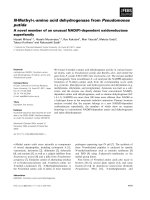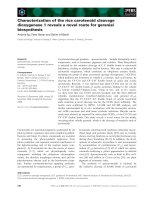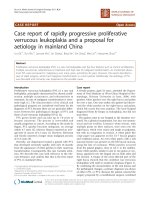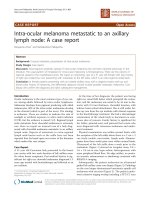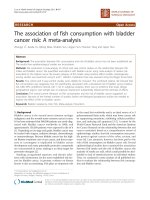Báo cáo khoa học: "Case report: severe heat stroke with multiple organ dysfunction – a novel intravascular treatment approach" doc
Bạn đang xem bản rút gọn của tài liệu. Xem và tải ngay bản đầy đủ của tài liệu tại đây (135.96 KB, 4 trang )
Open Access
Available online />R498
Vol 9 No 5
Research
Case report: severe heat stroke with multiple organ dysfunction –
a novel intravascular treatment approach
Gregor Broessner
1
, Ronny Beer
1
, Gerhard Franz
1
, Peter Lackner
1
, Klaus Engelhardt
1
,
Christian Brenneis
2
, Bettina Pfausler
3
and Erich Schmutzhard
4
1
Resident, Department of Neurology, Neurological Intensive Care Unit, Medical University, Innsbruck, Austria
2
Assistant Professor, Department of Neurology, Neurological Intensive Care Unit, Medical University, Innsbruck, Austria
3
Assistant Professor, Department of Neurology, Neurological Intensive Care Unit, Medical University, Innsbruck, Austria
4
Professor and Chairman, Department of Neurology, Neurological Intensive Care Unit, Medical University, Innsbruck, Austria
Corresponding author: Gregor Broessner,
Received: 7 May 2005 Accepted: 23 Jun 2005 Published: 20 Jul 2005
Critical Care 2005, 9:R498-R501(DOI 10.1186/cc3771)
This article is online at: />© 2005 Broessner et al.; licensee BioMed Central Ltd.
This is an Open Access article distributed under the terms of the Creative Commons Attribution License ( />2.0), which permits unrestricted use, distribution, and reproduction in any medium, provided the original work is properly cited.
Abstract
Introduction We report the case of a patient who developed a
severe post-exertional heat stroke with consecutive multiple
organ dysfunction resistant to conventional antipyretic
treatment, necessitating the use of a novel endovascular device
to combat hyperthermia and maintain normothermia.
Methods A 38-year-old male suffering from severe heat stroke
with predominant signs and symptoms of encephalopathy
requiring acute admission to an intensive care unit, was
admitted to a ten-bed neurological intensive care unit of a
tertiary care hospital. The patient developed consecutive
multiple organ dysfunction with rhabdomyolysis, and hepatic
and respiratory failure. Temperature elevation was resistant to
conventional treatment measures. Aggressive intensive care
treatment included forced diuresis and endovascular cooling to
combat hyperthermia and maintain normothermia.
Results Analyses of serum revealed elevation of
proinflammatory cytokines (TNF alpha, IL-6), cytokines (IL-2R),
anti-inflammatory cytokines (IL-4) and chemokines (IL-8) as well
as signs of rhabdomyolysis and hepatic failure. Aggressive
intensive care treatment as forced diuresis and endovascular
cooling (CoolGard
®
and CoolLine
®
) to combat hyperthermia
and maintain normothermia were used successfully to treat this
severe heat stroke.
Conclusion In this case of severe heat stroke, presenting with
multiple organ dysfunction and elevation of cytokines and
chemokines, which was resistant to conventional cooling
therapies, endovascular cooling may have contributed
significantly to the reduction of body temperature and, possibly,
avoided a fatal result.
Introduction
Heat stroke is a life-threatening disease characterized by
hyperpyrexia (elevated core body temperature exceeding
40°C) and predominant central nervous system dysfunction
resulting in delirium, convulsion or coma [1]. In many clinical
and pathogenetic aspects, heat stroke resembles sepsis,
requiring aggressive intensive care treatments, and there is
growing evidence that endotoxemia and cytokines may be
implicated in its pathogenesis [1-3]. We report a case of
severe heat stroke with secondary multiple organ dysfunction
being successfully treated with an intravascular cooling
device.
Case report
A 38-year-old male underwent a hiking tour on a hot, humid
day in late July 2003. At the end of this exhausting trip he com-
plained of dizziness, finally falling into an 'apathic' state. On the
arrival of the emergency physician, the patient suffered from a
generalized epileptic seizure. Subsequently, the comatose
patient (Glasgow Coma Scale 6 (E 1, V 1, M 4)) developed
respiratory insufficiency and cardiovascular failure (blood
pressure 60/20 mmHg, heart rate 166/min). He was immedi-
ately intubated (using fentanyl (0.3 mg), etomidate (40 mg)
and midazolam (20 mg)) and transported to our neurological
intensive care unit (NICU).
BUN = blood urea nitrogen; CK = creatine kinase; IL = interleukin; NICU = neurological intensive care unit; NSAIDs = non-steroidal anti-inflammatory
drugs; R = receptor; TNF = tumor necrosis factor.
Critical Care Vol 9 No 5 Broessner et al.
R499
On admission, the patient was deeply sedated and under anal-
gesia, but still suffering from hypotension requiring immediate
use of catecholamines (norepinephrine). The patient had nor-
mal weight (body mass index = 24) and no significant previous
medical history. The initial cerebral computed tomography
(CT) scan in combination with CT angiography did not reveal
any pathologies and, to exclude an infectious origin for the
central nervous system dysfunction, a lumbar puncture was
carried out yielding normal cerebrospinal fluid. An initial exten-
sive laboratory work up revealed impaired liver function
(glutamic-oxaloacetic transaminase 312U/l (normal range: 10
to 50 U/l), glutamic-pyruvic transaminase 244 U/l (normal
range: 10 to 50 U/l), gamma-glutamylcyclotransferase 94 U/l
(normal range: 10 to 66 U/l) and a prothrombin time of 60%
(normal range: 70 to 130%). Serum creatinine levels as well
as blood urea nitrogen (BUN) were elevated (creatinine 2.6
mg/100 ml (normal range: 0.8 to 1.3 mg/100 ml) and BUN 30
mg/100 ml (normal range: 5 to 25 mg/100 ml)) indicating the
beginning of renal failure. This situation was further compli-
cated by rhabdomyolysis with elevation of myoglobin and cre-
atine kinase (CK) (myoglobin peak level 33.124 µg/l (day 2),
normal range: 0 to 116 µg/l) and CK peak level 102.4 U/l (day
4), normal range: 38 to 174 U/l.
At the time of admission, core body temperature measured by
urinary bladder probe (Foley catheter; Kendall Curity, Mans-
field, MA, USA), was 40.8°C. During the first 20 h of treatment,
conventional temperature control methods including high-
dose non-steroidal anti-inflammatory drugs (NSAIDs) (acetyl-
salicylic acid 1000 mg and paracetamol 2000 mg) and opio-
ids (pethidine 100 mg), as well as external cooling devices
such as cooling blankets (Blanketrol II
®
, Cincinnati Sub-Zero,
Cincinnati, OH, USA) and Bair Hugger
®
(Arizant Healthcare
Inc, Eden Prairie, MN, USA), which were applied for 8 h, did
not lead to any significant decrease in core body temperature
(Figure 1). Because of subsequent deterioration of the
patient's condition and insufficient conventional temperature
control, an aggressive treatment approach with a novel intra-
vascular cooling system (CoolGard 3000
®
and Cool Line™,
Alsius, Irvine, CA, USA) was begun. The heat-exchange cath-
eter (Cool Line™) was placed into the left superior vena cava
and cooled saline was infused through a closed loop system
into two heat-exchange balloons located near the distal end of
the catheter. The temperature of the saline solution was
adjusted automatically by the CoolGard 3000
®
, which is an
external temperature control unit, according to feedback to the
external pump/refrigerant device from a microthermister
attached to a Foley bladder catheter. Target temperature was
set at 37°C for the first 25 h of intravascular treatment and
subsequently at 37.5°C. Target temperature was reached
within 7 h at a maximum cooling rate of 0.6°C/h and 'cooling'
was prolonged at this level.
Multiple organ dysfunction and secondary rhabdomyolysis led
to increased levels of myoglobin and CK (myoglobin peak level
33.124 µg/l (day 2), CK peak level 102.4 U/l (day 4)). To pre-
vent imminent renal failure, forced diuresis was initiated and
continued for 40 h using high-dose furosemide and fluids,
resulting in an urinary excretion rate of more than 400 ml/h,
leading to a fluid turnover of up to 24,000 ml/24 h. With this
aggressive measure, we suceeded in avoiding the use of extra-
corporal hemofiltration and the renal parameters returned to
normal values within 3 days.
Core body temperature was maintained at about 37°C and
subsequently maintained at 37.5°C (± 0.2°C) with the use of
the intravascular catheter over the next 5 days (Figure 1). Sev-
eral attempts to stop the active cooling within this period (Fig-
ure 1) led to an immediate steep increase of core body
temperature, which forced us to prolong this very efficacious
endovascular treatment. Finally, after 111.5 h, CoolGard
®
treatment was stopped, since most of the laboratory parame-
ters had stabilized; the patient did not suffer from hyperthermia
thereafter.
To confirm the diagnosis of severe heat stroke and to measure
the systemic inflammatory response [2], we analyzed levels of
plasma cytokines and serum chemokines 60 h after admission.
The results are shown in Table 1: soluble interleukin (IL) recep-
tor (sIL-2R) 1500 pg/ml, IL-4 3 pg/ml, IL-6 204 pg/ml, IL-8 40
pg/ml and tumor necrosis factor alpha (TNF alpha) 38 pg/ml
(IL-4, IL-6, IL-8, TNF alpha analyzed by immunoenzymometric
assay, Biosource, Nivelles, Belgium; IL-2R analyzed by immu-
noenzymometric assay, Immunotec, Marseille, France). On
days 5 and 7 after admission, the values of IL-6 had decreased
to 96 pg/ml (day 5) and 34 pg/ml (day 7), respectively.
Figure 1
Course of core body temperature in a patient with heat strokeCourse of core body temperature in a patient with heat stroke. The red
line denotes the core body temperature while using 'conventional' tem-
perature control methods. The blue line denotes the core body temper-
ature while using an endovascular (CoolGard
®
) cooling treatment. Blue
arrows denote the start of CoolGard
®
treatment. Red arrows denote
attempts to terminate the active cooling procedure.
Available online />R500
Initially diagnosed aspiration pneumonia as well as sinusitis
maxillaris diagnosed on the initial cerebral CT scan, were
treated with tazobactam/piperacilline and clindamycin. On day
3, somatosensoric potentials did not show any pathologic
results. The patient was extubated on day 8 and transferred to
a regular neurological ward on day 12 with neither signs of any
focal neurological nor overt cognitive deficits. At the time of
discharge from the NICU, laboratory parameters had returned
to normal values.
Results and discussion
Immediate cooling and support of organ-system function are
the two major therapeutic objectives in patients with heat
stroke [1,3,4]. Using conventional temperature control meas-
ures such as NSAIDs or external cooling devices (cooling
blankets and Bair Hugger
®
), even applied for several hours,
was ineffective in combating hyperthermia in this case. So far,
only one case has been reported in which a heat exchange bal-
loon was inserted in the femoral vein [5] leading to reduction
of core body temperature to 37-39°C. We succeeded in main-
taining the preset normothermia (37 to 37.5°C) for more than
5 days, thus both preventing neurological sequelae and rescu-
ing failing organ functions, in a patient with an expected mor-
tality rate of up to 50% [1,6]. For active cooling, we used the
Cool Line™ catheter placed into the upper vena cava in com-
bination with CoolGard 3000
®
. Studies could show that this
system is an efficacious tool for combating hyperthermia in
patients with severe primary intracranial diseases [7-9] but has
not been validated so far as a therapeutic tool in heat stroke.
The laboratory work up of chemokines (IL-8), proinflammatory
cytokines (TNF alpha, IL-6), cytokines (IL-2R) and anti-inflam-
matory cytokines (IL-4) revealed an elevation of all parameters,
which is of particular interest as it has been postulated that
these cytokines and chemokines may play an important role in
the pathogenesis of heat stroke [2]. In particular, the excessive
elevation of IL-6 and IL-2R found in our patient is remarkable
as these two markers may predict disease severity [1,2]. Con-
sidering these facts, the favorable neurologic outcome of our
patient after having suffered from this 'sepsis-like syndrome'
including multiple organ dysfunction, may be an indicator that
intravascular cooling and maintenance of normothermia influ-
ences the inflammatory response and may lead to improved
outcome in patients with heat stroke.
Conclusion
Heat stroke is a life-threatening disease requiring immediate
admission to an ICU. The progression to multiple organ dys-
function can be fatal as many organ systems may be affected.
The primary therapeutic goal must be to lower the core body
temperature, which may be impossible with conventional
measures. In our patient, intravascular treatment was effica-
cious and feasible. Prospective and controlled studies com-
paring the efficacy of various cooling techniques in NICU
patients have proven the feasibility and efficacy of this
endovascular cooling device (CoolGard 3000
®
and Cool
Line™), thus it should be considered as a possible alternative
to conventional treatment in heat stroke patients. In our
patient, maintenance of normothermia (37 to 37.5°C) led to a
favorable outcome with no neurologic impairment after the
'sepsis-like' heat stroke. Thus, further randomized and control-
led studies are warranted to evaluate intravascular cooling as
a possible tool in combating severe heat stroke.
Competing interests
The authors declare that they have no competing interests.
Table 1
Course of TNF alpha and IL levels in a patient with heat stroke
Parameters Normal range, pg/ml Measured values on day 3, pg/ml Measured values on day 5, pg/ml Measured values on day 7, pg/ml
sIL-2R 0–4.8 1500
IL-4 NA 3
IL-6 0–3 204 96 34
IL-8 NA 40
TNF alpha 0–20 38
IL, interleukin; NA, not available; TNF, tumor necrosis factor.
Key messages
• Heat stroke is a life-threatening disease requiring imme-
diate admission to an intensive care unit.
• Lowering the core body temperature must be the pri-
mary goal but conventional temperature control meas-
ures, as in our case, might be insufficient in decreasing
core body temperature.
• Intravascular cooling was efficacious and feasible in
maintaining "normothermia" (37°C – 37.5°C) in our
patient, leading to a favorable outcome.
• Intravascular cooling could be considered as a possible
alternative to conventional treatment in heat stroke
patients.
Critical Care Vol 9 No 5 Broessner et al.
R501
Authors' contributions
GB and ES coordinated the data analysis and drafted the
manuscript. RB, GF and BP participated in analysis of clinical
data. KE and CB participated in analysis of CoolGard 3000
®
data. PL helped to draft the manuscript. All authors read and
approved the final manuscript.
References
1. Bouchama A, Knochel JP: Heat stroke. N Engl J Med 2002,
346:1978-1988.
2. Lu KC, Wang JY, Lin SH, Chu P, Lin YF: Role of circulating
cytokines and chemokines in exertional heatstroke. Crit Care
Med 2004, 32:399-403.
3. Grogan H, Hopkins PM: Heat stroke: implications for critical
care and anaesthesia. Br J Anaesth 2002, 88:700-707.
4. White JD, Riccobene E, Nucci R, Johnson C, Butterfield AB,
Kamath R: Evaporation versus iced gastric lavage treatment of
heatstroke: comparative efficacy in a canine model. Crit Care
Med 1987, 15:748-750.
5. Megarbane B, Resiere D, Delahaye A, Baud FJ: Endovascular
hypothermia for heat stroke: a case report. Intensive Care Med
2004, 30:170.
6. Bouchama A: Heatstroke: a new look at an ancient disease.
Intensive Care Med 1995, 21:623-625.
7. Schmutzhard E, Engelhardt K, Beer R, Brossner G, Pfausler B,
Spiss H, Unterberger I, Kampfl A: Safety and efficacy of a novel
intravascular cooling device to control body temperature in
neurologic intensive care patients: a prospective pilot study.
Crit Care Med 2002, 30:2481-2488.
8. Marion DW: Controlled normothermia in neurologic intensive
care. Crit Care Med 2004, 32(Suppl 2):S43-45.
9. Diringer MN, Neurocritical Care Fever Reduction Trial Group:
Treatment of fever in the neurologic intensive care unit with a
catheter-based heat exchange system. Crit Care Med 2004,
32:559-564.
